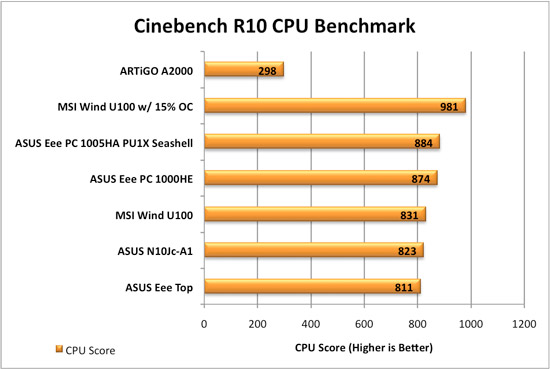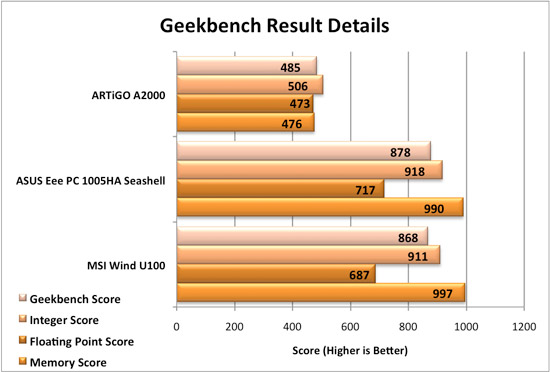VIA ARTiGO A2000 Barebone Storage Server
Benchmarking – Cinebench and Geekbench
First off, I felt like putting the ARTiGO A2000 through it’s graphical paces. If you ever take a look at the marketing text for this little storage server, they all mention the graphics hardware acceleration provided by the VIA Chrome9 HC3 DirectX 9 graphics engine. This always seemed odd to me, considering this computer is meant to be a storage server one normally locks in the closet after it’s up and running. So, to start, I ran the CINEBENCH 10 benchmark, a test based on the CINEMA 4D 3D software, and compared it to a number of similarly low-powered netbooks.

I don’t think anyone should be surprised to see the results putting the ARTiGO soundly behind any of the netbooks, each of which were built to maximize the graphical interface so users could still enjoy the typical graphic-intensive applications they are used to running. While the tests didn’t vindicate the marketing, they are really meaningless for this system considering its purpose; I mostly ran this test for the fun of it and to prove marketing isn’t always something to believe.
Next up was a more useful, general benchmark of the system’s computing power. Aside from running typical applications, a lot of a computer’s time is spent moving and processing data from or to the network and from or to the hard drive. The ability to process efficiently aids in moving this data as quickly as the hardware can support it; that is, we would hope the CPU and motherboard is not the bottleneck when it comes to data storage. Additionally, solid scores on general CPU tests would indicate the system would quickly handle compressed files and, potentially, media encoding. To perform this test, I used the Geekbench benchmarking software and compared the resulting scores to some netbooks we have tested in the past.

Again, the Geekbench tests showed the ARTiGO A2000 performed well behind the two other netbooks included in the comparison, particularly in the Memory tests where the ARTiGO A2000 scored less than half as well. Of course, it would be unfair to forget that my test system is only using a single 512 MB DDR2-667 module while both the netbooks had 1GB of RAM. Nonetheless, I think it’s safe to conclude that the ARTiGO A2000 may not be the best system for performing processor intensive tasks, and encoding media is out of the question so long as you ever want it to finish. Still, as before, this test doesn’t necessarily mean anything since the ARTiGO A2000 is still only just a storage server. What we really need to see is how it handles data and network operations. Let us go onward!

Comments are closed.